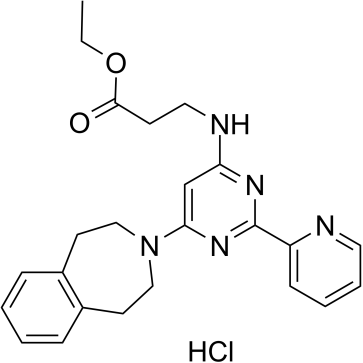GSK-J4 Hydrochloride
Modify Date: 2024-01-11 18:05:25

GSK-J4 Hydrochloride structure
|
Common Name | GSK-J4 Hydrochloride | ||
|---|---|---|---|---|
| CAS Number | 1797983-09-5 | Molecular Weight | 453.964 | |
| Density | N/A | Boiling Point | N/A | |
| Molecular Formula | C24H28ClN5O2 | Melting Point | N/A | |
| MSDS | N/A | Flash Point | N/A | |
Use of GSK-J4 HydrochlorideGSK-J4 hydrochloride is a potent dual inhibitor of H3K27me3/me2-demethylases JMJD3/KDM6B and UTX/KDM6A with IC50s of 8.6 and 6.6 μM, respectively. GSK-J4 hydrochloride inhibits LPS-induced TNF-α production in human primary macrophages with an IC50 of 9 μM. GSK-J4 hydrochloride is a cell permeable prodrug of GSK-J1[1][2][3]. |
| Name | Ethyl N-[2-(2-pyridinyl)-6-(1,2,4,5-tetrahydro-3H-3-benzazepin-3-yl)-4-pyrimidinyl]-β-alaninate hydrochloride (1:1) |
|---|---|
| Synonym | More Synonyms |
| Description | GSK-J4 hydrochloride is a potent dual inhibitor of H3K27me3/me2-demethylases JMJD3/KDM6B and UTX/KDM6A with IC50s of 8.6 and 6.6 μM, respectively. GSK-J4 hydrochloride inhibits LPS-induced TNF-α production in human primary macrophages with an IC50 of 9 μM. GSK-J4 hydrochloride is a cell permeable prodrug of GSK-J1[1][2][3]. |
|---|---|
| Related Catalog | |
| Target |
IC50: 8.6 µM (JMJD3/KDM6B), 6.6 µM (UTX/KDM6A)[6] |
| In Vitro | GSK-J4 Hydrochloride has cellular activity in Flag-JMJD3-transfected HeLa cells, in which GSK-J4 prevents the JMJD3-induced loss of nuclear H3K27me3 immunostaining. Administration of GSK-J4 increases total nuclear H3K27me3 levels in untransfected cells. GSK-J4 significantly reduces the expression of 16 of 34 LPS-driven cytokines, including tumour-necrosis factor-α (TNF-α)[1]. GSK-J4 Hydrochloride (5 μM; 48 hours) causes a more than 3-fold increase in mouse podocyte H3K27me3 content. H3K27me3 levels in cultured podocytes, GSK-J4 reduces Jagged-1 mRNA and Jagged-1 protein levels. Correspondingly, when exposed podocytes to the inducer of dedifferentiation TGF-β1, pretreatment with GSK-J4 preventes both the increase in intracellular N1-ICD levels and the increase in α-SMA and the decrease in podocin mRNA levels[2]. GSK-J4 Hydrochloride (10, 25 nM) acts upon DCs promoting the differentiation of Treg cells, improving Treg stability and suppressive capacities, without affecting the differentiation of Th1 and Th17 cells[3]. GSK-J4 Hydrochloride inhibits JMJD3 expression that is induced by TGF-β1[4]. GSK-J4 Hydrochloride inhibits H3K4 demethylation at Xist, Nodal, and HoxC13 in female embryonic stem cells[5]. |
| In Vivo | GSK-J4 Hydrochloride (10 mg/kg; i.p.; thrice-weekly for 10 weeks) attenuates the development of kidney disease in diabetic mice[2]. GSK-J4 Hydrochloride (0.5 mg/kg, i.p.) significantly reduces the severity and delays the onset of the disease of the mouse model of experimental autoimmune encephalomyelitis[3]. Animal Model: Eight-week-old male db/m and db/db mice on a BKS background[2] Dosage: 10 mg/kg Administration: i.p.; thrice-weekly for 10 weeks Result: Attenuated the development of kidney disease in diabetic mice. |
| References |
[6]. Heinemann B, et al. Inhibition of demethylases by GSK-J1/J4. Nature. 2014 Oct 2;514(7520):E1-2 |
| Molecular Formula | C24H28ClN5O2 |
|---|---|
| Molecular Weight | 453.964 |
| Exact Mass | 453.193146 |
| MFCD26142638 |
| Ethyl N-[2-(2-pyridinyl)-6-(1,2,4,5-tetrahydro-3H-3-benzazepin-3-yl)-4-pyrimidinyl]-β-alaninate hydrochloride (1:1) |
| β-Alanine, N-[2-(2-pyridinyl)-6-(1,2,4,5-tetrahydro-3H-3-benzazepin-3-yl)-4-pyrimidinyl]-, ethyl ester, hydrochloride (1:1) |